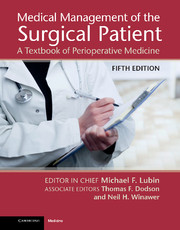Book contents
- Frontmatter
- Dedication
- Contents
- List of Contributors
- Preface
- Introduction
- Part 1 Perioperative Care of the Surgical Patient
- Part 2 Surgical Procedures and their Complications
- Section 17 General Surgery
- Section 18 Cardiothoracic Surgery
- Section 19 Vascular Surgery
- Section 20 Plastic and Reconstructive Surgery
- Section 21 Gynecologic Surgery
- Section 22 Neurologic Surgery
- Section 23 Ophthalmic Surgery
- Section 24 Orthopedic Surgery
- Chapter 116 Arthroscopic knee surgery
- Chapter 117 Total knee replacement
- Chapter 118 Total hip replacement
- Chapter 119 Fractures of the femoral shaft
- Chapter 120 Hip fractures
- Chapter 121 Lumbar spine surgery
- Chapter 122 Surgery for adult spinal deformity (scoliosis or kyphosis)
- Chapter 123 Cervical spine surgery
- Chapter 124 Surgery of the foot and ankle
- Chapter 125 Lower extremity amputations
- Chapter 126 Surgical procedures for rheumatoid arthritis
- Section 25 Otolaryngologic Surgery
- Section 26 Urologic Surgery
- Index
- References
Chapter 117 - Total knee replacement
from Section 24 - Orthopedic Surgery
Published online by Cambridge University Press: 05 September 2013
- Frontmatter
- Dedication
- Contents
- List of Contributors
- Preface
- Introduction
- Part 1 Perioperative Care of the Surgical Patient
- Part 2 Surgical Procedures and their Complications
- Section 17 General Surgery
- Section 18 Cardiothoracic Surgery
- Section 19 Vascular Surgery
- Section 20 Plastic and Reconstructive Surgery
- Section 21 Gynecologic Surgery
- Section 22 Neurologic Surgery
- Section 23 Ophthalmic Surgery
- Section 24 Orthopedic Surgery
- Chapter 116 Arthroscopic knee surgery
- Chapter 117 Total knee replacement
- Chapter 118 Total hip replacement
- Chapter 119 Fractures of the femoral shaft
- Chapter 120 Hip fractures
- Chapter 121 Lumbar spine surgery
- Chapter 122 Surgery for adult spinal deformity (scoliosis or kyphosis)
- Chapter 123 Cervical spine surgery
- Chapter 124 Surgery of the foot and ankle
- Chapter 125 Lower extremity amputations
- Chapter 126 Surgical procedures for rheumatoid arthritis
- Section 25 Otolaryngologic Surgery
- Section 26 Urologic Surgery
- Index
- References
Summary
Total knee replacement is indicated for end-stage degeneration of the knee joint with loss of articular (joint surface) cartilage. The most common reasons for this operation are osteoarthritis (idiopathic or post-traumatic) and inflammatory arthritis (rheumatoid, psoriatic, etc.). Total knee replacement is typically considered once all other conservative modalities (oral medications, intra-articular injections, physical therapy, weight loss, etc.) have failed to relieve the pain and dysfunction associated with knee degeneration.
The natural knee joint consists of three compartments: lateral, medial, and patellofemoral. A total knee replacement is designed to resurface the damaged articular surfaces of these compartments. Both the femoral and tibial components are typically made from metal. A high-density plastic (polyethylene) insert is placed between the metal components to serve as the artificial cartilage of the joint. Highly crosslinked polyethylene may be utilized as a more wear-resistant bearing surface; however, long-term results with this type of plastic are not yet available. Most total knee replacements also resurface the patella with an all-polyethylene component. Fixation of the metal components to the bone is typically done with bone cement, but some designs allow for fixation by bony ingrowth into porous metal surfaces applied to the surface of the implant, which is placed against the bone. By removing all damaged surfaces of the knee, pain can be alleviated and function restored.
- Type
- Chapter
- Information
- Medical Management of the Surgical PatientA Textbook of Perioperative Medicine, pp. 715 - 717Publisher: Cambridge University PressPrint publication year: 2013

